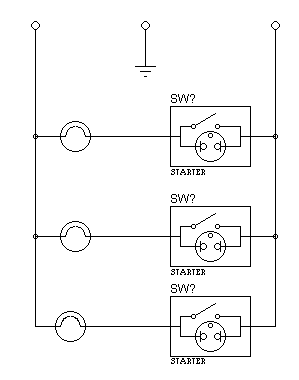![[DMX512 Home]](/web/home.gif)
|
![[Link Finder!]](/unweb/linkfind.gif)
|
|
|
![[DMX512 Home]](/web/home.gif)
|
![[Link Finder!]](/unweb/linkfind.gif)
|
|
|
Ever wonder just how hard it is to build a log fire that flickers like the real thing? One that really looks good?? Wonder what sort of console and how many dimmer channels, or what kind of program patch you need to make it look just right???
The answer is, it's easy, and needs only one dimmer channel. Plus a couple of hours work in the shed. The technique described doesn't appear to be published in any of the standard stage lighting works, but has been used for many years, the "secret" having been handed from lighting tech to lighting tech.
I was shown this trick by a chap called Brian Beckley, who was a very accomplished stage director for an amateur theatrical association of associations called NATHDA ('The Norbury and Thornton Heath Drama Association'), on a little lighting course he once ran. Mind you, that must have been over a decade (or two) ago. However the trick works as well in the 90's as it did then. Thank you Brian.
This project uses mains voltages, which are hazardous, and can cause death. Your insurance company may not like you building this project, nor may they like you using one of these in a show. Your theatre may even object to you using DIY effects in their venue. Ensure that you (and your show) have appropriate cover for your activities and liabilities.
And be sure to read our disclaimer.
![[External view]](outside.jpg)
The flickering effect is generated by simply using a low wattage coloured bulb in series with a fluorescent tube starter. The starter does it's thing, and tries to start the 'tube', but of course, it never can. So your bulb just keeps flickering in (and this is what makes the effect look good) a random and unpredicatable way.
Of course, real fires have more than a single flame, so grouping together a number of these flickering lights (I like to use three) and using different coloured bulbs (I like to use opaque red, clear red, and amber) makes the effect more realistic.
The only other thing to say is that the effect works best if you have your dimmer set at 50-60%; like many good lights this one looses it if you turn the wick all the way up.
Thats all there is to it!
Although this trick works well in both 110V and 230V countries, the type of starter needs to be varied, due to the different avalanche voltages. Sadly, I've lost track of the citizen of the USA who pointed this out to me, some considerable time ago.
| Voltage | Starter | Bulb wattage |
|---|---|---|
| 110V | 6-8W | 40W |
| 230V | Universal | 40W |

This effect can be constructed in any way you wish to suit the type of fire you are attempting to simulate. The lamps and starters can most easily be assembled either on a square of wood, or using a metal box with the bulbs on top, and the starters inside. Either way works well.
Then bury the arrangement in schrunched up gel, of appropriate fire type colours and shape to fit your 'fire'. 40W GLS bulbs don't get particularly hot when used in this application, so you shouldn't end up creating a real fire on stage, providing there is adequate ventilation around the bulbs and gel. If in doubt, fit a small fan.
If you use a metal box, ensure it is grounded. Adopt good wiring techniques, and use quality components throughout. Ensure the mains lead is anchored firmly as it connects to the arrangement. Ensure that if the mains lead is pulled from your arrangement, the ground lead is the last to disconnect. Remember this thing will be used on stage, and you don't want your effect to be frying any actors. This is an effect, a simulation, not the real thing.
One last thing - change the starters every now and again. They were never intended for this sort of duty cycle, and I suspect they probably wear out.
![[Inside view]](inside.jpg)
I saw this little article, and thought I'd include it here. Note that I wouldn't necessarily recommend doing some of these things, many of the loads suggested will not be best pleased at being powered through a starter, so proceed with caution!
From: Clive Mitchell
|
Comments and suggestions are welcomed by the webmaster, please use this
contact form
DMX512.com site and linking information.
And be sure to read our disclaimer.